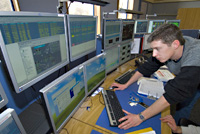Sulekha Rani.R ,PGT Chemistry,KV NTPC Kayamkulam
Higgs within reach….
Our understanding of the universe is
about to change…
(A proton-proton collision event in the CMS experiment
producing two high-energy photons (red towers). This is what we would expect to
see from the decay of a Higgs boson but it is also consistent with background
Standard Model physics processes. © CERN 2012)

The ATLAS and CMS experiments at CERN today presented their latest
results in the search for the long-sought Higgs
boson. Both experiments see strong
indications for the presence of a new particle, which could be the Higgs boson,
in the mass region around 126 gigaelectronvolts (GeV).
The experiments found hints of the new
particle by analysing trillions of proton-proton collisions from the Large Hadron Collider (LHC) in 2011 and 2012. TheStandard
Model of particle physics predicts that a
Higgs boson would decay into different particles – which the LHC experiments
then detect.
Both ATLAS and CMS
gave the level of significance of the result as 5 sigma on the scale that
particle physicists use to describe the certainty of a discovery. One sigma
means the results could be random fluctuations in the data, 3 sigma counts as
an observation and a 5-sigma result is a discovery. The results presented today
are preliminary, as the data from 2012 is still under analysis. The complete
analysis is expected to be published around the end of July.
Press Release….
CERN experiments
observe particle consistent with long-sought Higgs boson
Geneva, 4 July 2012. At a
seminar held at CERN today as a curtain raiser
to the year’s major particle physics conference, ICHEP2012 in Melbourne, the
ATLAS and CMS experiments presented their latest preliminary results in the
search for the long sought Higgs particle. Both experiments observe a new
particle in the mass region around 125-126 GeV.
“We
observe in our data clear signs of a new particle, at the level of 5 sigma, in
the mass region around 126 GeV. The outstanding performance of the LHC and
ATLAS and the huge efforts of many people have brought us to this exciting
stage,” said ATLAS experiment spokesperson Fabiola Gianotti, “but a little more time is needed to prepare
these results for publication.”
"The
results are preliminary but the 5 sigma signal at around 125 GeV we’re seeing
is dramatic. This is indeed a new particle. We know it must be a boson and it’s
the heaviest boson ever found,” said CMS experiment spokesperson Joe Incandela. “The implications are very significant and
it is precisely for this reason that we must be extremely diligent in all of
our studies and cross-checks."
“It’s
hard not to get excited by these results,” said CERN Research Director Sergio Bertolucci. “
We stated last year that in 2012 we would either find a new Higgs-like particle
or exclude the existence of the Standard Model Higgs. With all the necessary
caution, it looks to me that we are at a branching point: the observation of
this new particle indicates the path for the future towards a more detailed
understanding of what we’re seeing in the data.”
The results presented today
are labelled preliminary. They are based on data collected in 2011 and 2012,
with the 2012 data still under analysis. Publication of the analyses
shown today is expected around the end of July. A more complete picture of
today’s observations will emerge later this year after the LHC provides the
experiments with more data.
The next step will be to
determine the precise nature of the particle and its significance for our
understanding of the universe. Are its properties as expected for the
long-sought Higgs boson, the final missing ingredient in the Standard Model of
particle physics? Or is it something more exotic? The Standard Model describes
the fundamental particles from which we, and every visible thing in the
universe, are made, and the forces acting between them. All the matter that we
can see, however, appears to be no more than about 4% of the total. A more
exotic version of the Higgs particle could be a bridge to understanding the 96%
of the universe that remains obscure.
“We
have reached a milestone in our understanding of nature,” said CERN Director General
Rolf Heuer. “The discovery of a particle consistent
with the Higgs boson opens the way to more detailed studies, requiring larger
statistics, which will pin down the new particle’s properties, and is likely to
shed light on other mysteries of our universe.”
Positive identification of
the new particle’s characteristics will take considerable time and data. But
whatever form the Higgs particle takes, our knowledge of the fundamental
structure of matter is about to take a major step forward.
(((((About CERN…CERN, the
European Organization for Nuclear Research, is the world's leading laboratory
for particle physics. It has its headquarters in Geneva. At present, its Member
States are Austria, Belgium, Bulgaria, the Czech Republic, Denmark, Finland,
France, Germany, Greece, Hungary, Italy, the Netherlands, Norway, Poland,
Portugal, Slovakia, Spain, Sweden, Switzerland and the United Kingdom. Romania
is a candidate for accession. Israel and Serbia are Associate Members in the
pre-stage to Membership. India, Japan, the Russian Federation, the United
States of America, Turkey, the European Commission and UNESCO have Observer
status.)))))







































